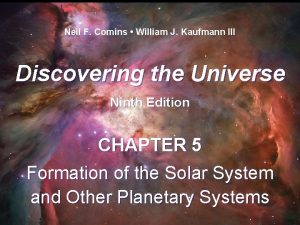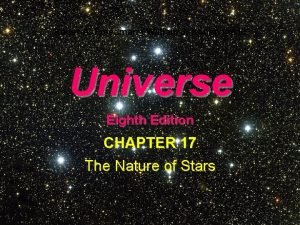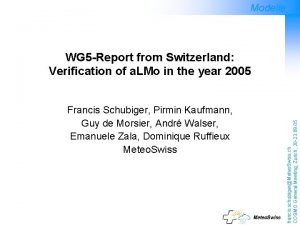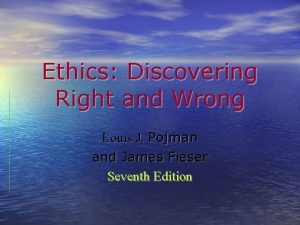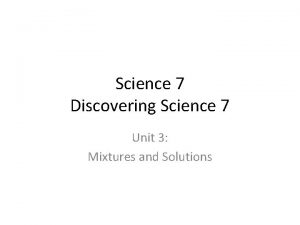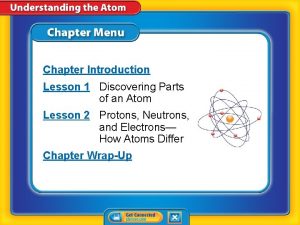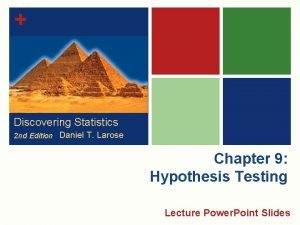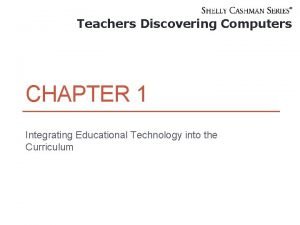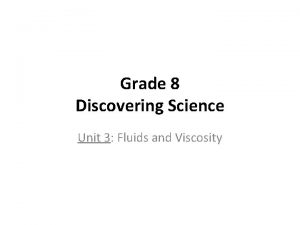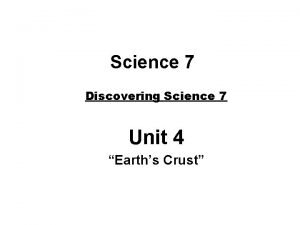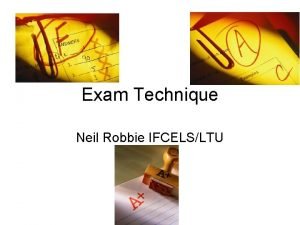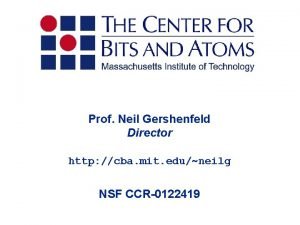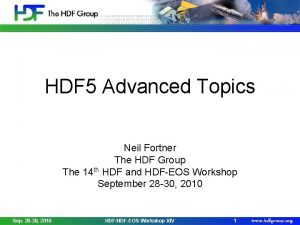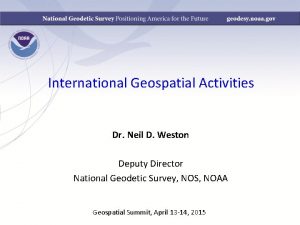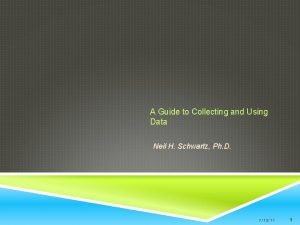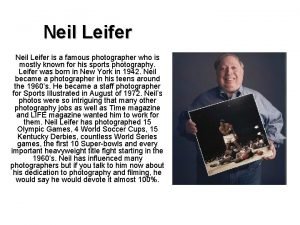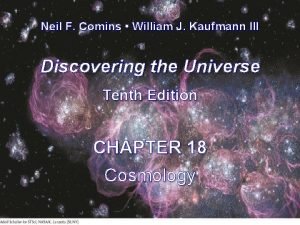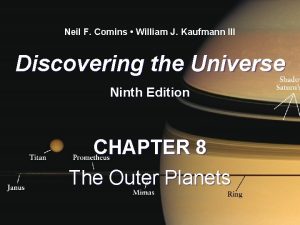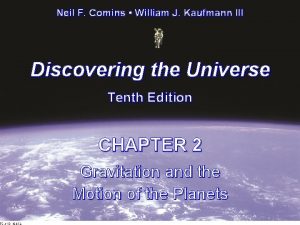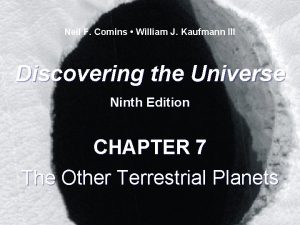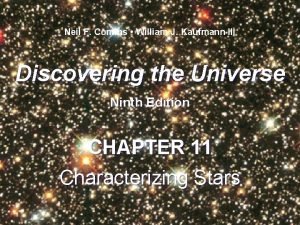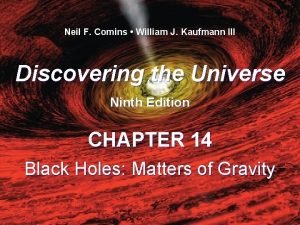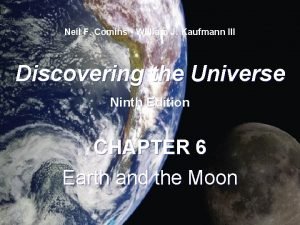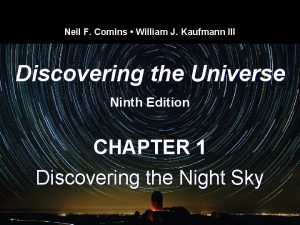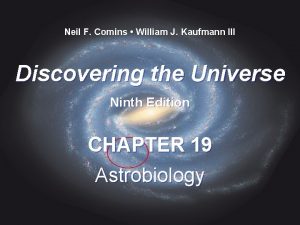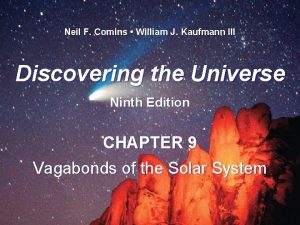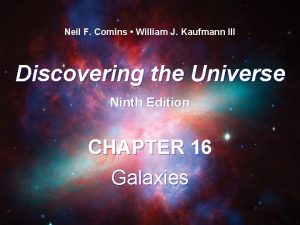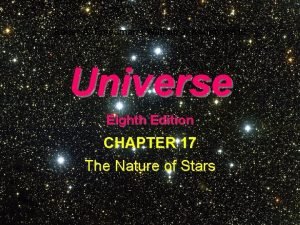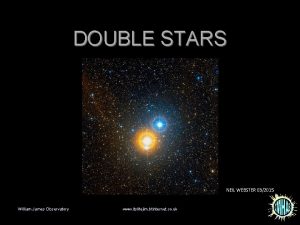Neil F Comins William J Kaufmann III Discovering




























































- Slides: 60

Neil F. Comins • William J. Kaufmann III Discovering the Universe Ninth Edition CHAPTER 3 Light and Telescopes

WHAT DO YOU THINK? l l l What is light? What type of electromagnetic radiation is most dangerous to life? What is the main purpose of a telescope? Why do all research telescopes use mirrors, rather than lenses, to collect light? Why do stars twinkle?

In this chapter you will discover… l l l l the connection between visible light, radio waves, and other types of electromagnetic radiation the debate in past centuries over what light is and how Einstein resolved this question how telescopes collect and focus light why different types of telescopes are used for different types of research the limitations of telescopes, especially those that use lenses to collect light what the new generations of land-based and spacebased high-technology telescopes being developed can do how astronomers use the entire spectrum of electromagnetic radiation to observe the stars and other astronomical objects and events

When a beam of white light passes through a glass prism, the light is separated or refracted into a rainbow-colored band called a spectrum. The numbers on the right side of the spectrum indicate wavelengths in nanometers (1 nm = 10 -9 m).

This drawing of Newton’s experiment illustrates that glass does not add to the color of light, only changes its direction. Because color is not added, this experiment shows that color is an intrinsic property of light.

Electromagnetic radiation travels as waves. Thomas Young’s interference experiment shows that light of a single color passing through a barrier with two slits behaves as waves that create alternating light and dark patterns on a screen.

Water waves passing through two slits in a ripple tank create interference patterns. As with light, the water waves interfere with each other, creating constructive interference (crests) and destructive interference (troughs) throughout the right side of the tank and on the far right wall.

In 1860, James Clerk Maxwell combined and unified the current theories of electricity and magnetism and showed that electric and magnetic fields should travel through space together in the form of electromagnetic waves. These waves are characterized by their wavelength, the distance between two peaks in a wave.

Ole Rømer used two eclipses of one of Jupiter’s moons to first show that light does not travel infinitely fast and to measure its speed. One can also use Maxwell’s equations to calculate the speed of light.

This photograph shows the visible colors separated by a prism. The two thermometers in the region illuminated by visible light have temperatures less than thermometer to the right of red. Therefore, there must be more radiation energizing (that is, heating) the warmest thermometer. This energy is what we call infrared radiation— invisible to the human eye, but detectable as heat.

There a wide range of wavelengths of electromagnetic waves which are plotted on the electromagnetic spectrum. We classify these waves depending upon their source, use, or interactions with other matter. Only a very small range of wavelengths, 400 nm to 700 nm, is visible to humans. (Since these wavelengths are small, we describe them in terms of nanometers (10 -9 m) or angstroms (Å; 10 -10 m). Other wavelengths are classified as gamma rays, X rays, ultraviolet radiation, infrared radiation, microwaves, or radio waves.

The transparency of a material depends on the wavelength of light. Earth’s atmosphere is relatively transparent to visible light and radio waves, which are referred to as “windows” through which we can view space from a ground-based telescope.

This replica of Newton’s reflecting telescope was built in 1672. This reflecting telescope has a spherical primary mirror 3 cm (1. 3 in. ) in diameter. Its magnification was 40 x.

(a)The angle at which a beam of light strikes a mirror (the angle of incidence, i ) is always equal to the angle at which the beam is reflected from the mirror (the angle of reflection, r).

The large mirror used to gather and focus the light in a reflecting telescope is called the primary mirror. The surface of the mirror used is bent into a curve. Parallel light rays from distant objects converge to a focal point. The distance between the mirror and its focal point is called the focal length.

A Newtonian telescope uses a flat secondary mirror to redirect the focused image to the side of the telescope for viewing. The image is viewed through a small focal length lens called an eyepiece.

Even though light rays from stars spread out in all directions, they must travel over huge interstellar distances to reach Earth. Therefore, the rays that enter our telescopes are essentially traveling in the same direction and thus are considered parallel. If the object we are examining is an extended object, such as the Moon, then the light rays converge in a focal plane rather than a single point.

Four of the most common optical designs for reflecting telescopes: (a) Newtonian focus (popular among amateur astronomers) and the three major designs used by researchers—(b) Cassegrain focus, (c) Nasmyth focus or coudé focus, and (d) prime focus.

Light-Gathering Power Because a large primary mirror collects more starlight than does a smaller one, a larger telescope produces a brighter image than a smaller one, all other things being equal. The same principle applies to telescopes that collect light using an objective lens rather than a primary mirror. The two photographs of the Andromeda Galaxy were taken through telescopes with different diameters and were exposed for equal lengths of time at equal magnification.

The larger the diameter of a telescope’s primary mirror, the finer the detail the telescope can resolve. These two images of the Andromeda Galaxy, taken through telescopes with different diameters, show this effect. Increasing the exposure time of the smaller diameter telescope (a), will only brighten the image, not improve the resolution.

The same telescope can magnify by different amounts, depending on the focal length of the eyepiece. (a) A lowmagnification image of the Moon. (b) An image of the Moon taken with magnification 4 times greater than image (a). Note in this case that the increased magnification leads to increased resolution (i. e. , more detail can be seen in the larger image).

New technology has created charge-coupled devices (CCDs) that gather light more efficiently than photographic plates.

This image of the Rosette Nebula, a region of star formation 5000 ly away in the constellation Monoceros (the Unicorn), was taken with this CCD. It shows the incredible detail that can be recorded by large telescopes and high-resolution CCDs.

These three views of the same part of the sky, each taken with the same 4 -m telescope, compare CCDs to photographic plates. (a) A negative print (black stars and white sky) of a photographic image. (b) A negative CCD image. Notice that many faint stars and galaxies that are invisible in the ordinary photograph can be seen clearly in this CCD image. (c) This (positive) color view was produced by combining a series of CCD images taken through colored filters.

Light rays traveling into a transparent medium such as glass bend at the surface. The bending of light rays between two transparent media is called refraction. If the lens is curved, parallel rays will converge at a focal point just like the rays in a reflecting telescope.

The straw as seen through the side of the liquid is magnified and offset from the straw above the liquid because the liquid is given a curved shape by the side of the glass. The straw as seen through the top of the liquid is refracted but does not appear magnified because the surface of the water is flat and the beaker has uniform thickness.

Light from objects larger than points in the sky does not all converge to the focal point of a lens. Rather, the object creates an image at the focal length in what is called the focal plane.

A refracting telescope consists of a large, long-focal-length objective lens that collects and focuses light rays and a small, short-focal-length eyepiece lens that restraightens the light rays. The lenses work together to brighten, resolve, and magnify the image formed at the focal plane of the objective lens.

Different colors of light are refracted differently and have different focal points. Thus, all the colors of the image will not be focused at once. This is called chromatic aberration. It is difficult to grind a lens into the proper shape to have all parallel rays converge at a single focal point. The weight of a large lens can cause the lens to sag and distort the image. Air bubbles in the glass cause unwanted refractions, distorting the image. Glass is opaque to certain wavelengths of light, meaning that those wavelengths do not go through the glass. Yerkes Observatory

These issues do not affect reflecting telescopes because the light from the stars does not travel through a glass lens before being focused. However, reflecting telescopes do have some problems. One problem is that the secondary mirror used to deflect the light out the side partially blocks the light from the star.

Another problem with reflecting telescopes is called spherical aberration. When a spherically shaped mirror is used, the light rays hitting far from the center do not converge at the same point. One solution is to instead grind the mirror into a parabolic shape. Another solution is to use a correcting lens to make all the light rays converge at a single point.

(a) To make each 8. 4 -m primary mirror for the Large Binocular Telescope II on Mount Graham in Arizona, 40, 000 pounds of glass are loaded into a rotating furnace and heated to 1450 K (2150°F). This image shows glass fragments loaded into the cylindrical furnace. (b) After melting, spinning, and cooling, the mirror’s parabolic surface is ready for final smoothing and coating with a highly reflective material.

There are four basic types of telescope mounts that steer the telescopes around the sky: The Fork Equatorial Mount, the German Equatorial Mount, the Altitude-Azimuth (Alt-Azimuth) Mount, and the Dobsonian Mount.

The same star field photographed with (a) a ground-based telescope, which is subject to poor seeing conditions that result in stars twinkling, and (b) the Hubble Space Telescope, which is free from the effects of twinkling.

The view from Kitt Peak in 1959 The same skyline in 1989 These two images of Tucson, Arizona, were taken from the Kitt Peak National Observatory, which is 38 linear miles away. They show the dramatic growth in ground light output between 1959 and 1989. Since 1972, light pollution, a problem for many observatories around the world, has been at least partially controlled by a series of local ordinances.

This photograph of the Hubble Space Telescope (HST) hovering above the space shuttle’s cargo bay was taken in 1993, at completion of the first servicing mission. HST has studied the heavens at infrared, visible light, and ultraviolet wavelengths.

Using adaptive optics, which calculate the amount of twinkling of our atmosphere and change the shape of the mirror accordingly, we can receive better images from ground-based telescopes. (a) Image of Neptune from an Earth-based telescope without adaptive optics. (b) Image of Neptune from the same Earth-based telescope with adaptive optics. (c) Image of Neptune from the Hubble Space Telescope, which does not incorporate adaptive optics technology.

The 10 -m Keck telescopes are located on the dormant (and hopefully extinct) Mauna Kea volcano in Hawaii. These huge twin telescopes each consist of 36 hexagonal mirrors measuring 1. 8 m (5. 9 ft) across. Each Keck telescope has the light-gathering, resolving, and magnifying ability of a single mirror 10 m in diameter. Inset: View down the Keck I telescope. The hexagonal apparatus near the top of the photograph shows the housing for the 1. 4 -m secondary mirror.

Orion as Seen in Visible, Ultraviolet, and Infrared Wavelengths (a) This is an ordinary optical photograph of the constellation Orion. (b) This is an ultraviolet image of Orion obtained during a brief rocket flight on December 5, 1975. The 100 -s exposure captured wavelengths ranging from 125 to 200 nm. (c) A false-color view from the Infrared Astronomical Satellite uses color to display the intensity of infrared wavelengths.

Recall that the secondary mirror or prime focus on most telescopes blocks incoming light or other radiation. This new radio telescope at the National Radio Astronomy Observatory in Green Bank, West Virginia, has its prime focus hardware located offcenter from the telescope’s 100 -m x 110 -m oval reflector. By using this new design, there is no such loss of signal. Such configurations are also common on microwave dishes used to receive satellite transmissions for home televisions. National Radio Astronomy Observatory, Green Bank, WV

The 27 radio telescopes of the Very Large Array (VLA) system are arranged along the arms of a Y in central New Mexico. Besides being able to change the angles at which they observe the sky, these telescopes can be moved by train cars so that the array can detect either wide areas of the sky (when the telescopes are close together, as in this photograph) or small areas with higher resolution (when they are farther apart). The inset shows the traditional secondary mirror assembly in the center of each of these antennas.

VISIBLE LIGHT RADIO WAVES The visible light picture was taken by a camera on board a spacecraft as it approached Saturn. The view was produced by sunlight scattered from the planet’s cloud tops and rings. The radio image is a false-color picture, taken by the VLA, and shows radio emission from Saturn at a wavelength of 2 cm.

Spitzer Space Telescope (a) The mirror assembly for the Spitzer Space Telescope, showing the 85 -cm objective mirror. (b) Launched in 2003, this Great Observatory is taking images and spectra of planets, comets, gas, and dust around other stars and in interstellar space, galaxies, and of the large-scale distribution of matter in the universe. Inset: An infrared image of a region of star formation invisible to optical telescopes.

Views of the Milky Way’s Central Regions (a) An optical image in the direction of Sagittarius, toward the Milky Way’s center. The dark regions are interstellar gas and dust clouds that prevent visible light from beyond them from reaching us. (b) An infrared image of the same area of the sky, showing many more distant stars whose infrared radiation passes through the clouds and is collected by our telescopes.

Nonvisible and Visible Radiation (a) The Mc. Math-Pierce Solar Telescope at Kitt Peak Observatory near Tucson, Arizona (the inverted V-shaped structure), takes visible-light photographs of the Sun, such as the one shown in the inset. Comparing the images in the two insets reveals how important observing nonvisible radiation from astronomical phenomena is to furthering our understanding of how the universe operates. (b) This X-ray telescope was carried aloft in 1994 by the space shuttle. The inset shows an X-ray image of the Sun. Comparing the images in the two insets reveals how important observing nonvisible radiation from astronomical phenomena is to furthering our understanding of how the universe operates.

X rays penetrate objects they strike head on. To focus them, X rays have to be gently nudged by skimming off cylindrical “mirrors. ” The shapes of the mirrors optimize the focus. The bottom diagram shows how X rays are focused in the Chandra X-ray Telescope.

Survey of the Universe in Various Parts of the Electromagnetic Spectrum (a) Visible light (b) Radio waves (c) Infrared radiation (d) X rays (e) Gamma rays

Summary of Key Ideas

The Nature Of Light l l Photons, units of vibrating electric and magnetic fields, all carry energy through space at the same speed, the speed of light (300, 000 km/s in a vacuum, slower in any medium). Radio waves, microwaves, infrared radiation, visible light, ultraviolet radiation, X rays, and gamma rays are the forms of electromagnetic radiation. They travel as photons, sometimes behaving as particles, sometimes as waves.

The Nature Of Light l l l Visible light occupies only a small portion of the electromagnetic spectrum. The wavelength of a visible-light photon is associated with its color. Wavelengths of visible light range from about 400 nm for violet light to 700 nm for red light. Infrared radiation, microwaves, and radio waves have wavelengths longer than those of visible light. Ultraviolet radiation, X rays, and gamma rays have wavelengths that are shorter.

Optics and Telescopes l l A telescope’s most important function is to gather as much light as possible. When possible, it also resolves (reveals details) and magnifies an object. Reflecting telescopes, or reflectors, produce images by reflecting light rays from concave mirrors to a focal point or focal plane.

Optics and Telescopes l l Refracting telescopes, or refractors, produce images by bending light rays as they pass through glass lenses. Glass impurity, opacity to certain wavelengths, and structural difficulties make it inadvisable to build extremely large refractors. Reflectors are not subject to the problems that limit the usefulness of refractors. Earth-based telescopes are being built with active optics and adaptive optics. These advanced technologies yield resolving power comparable to the Hubble Space Telescope.

Nonoptical Astronomy l l l Radio telescopes have large, reflecting antennas (dishes) that are used to focus radio waves. Very sharp radio images are produced with arrays of radio telescopes linked together in a technique called interferometry. Earth’s atmosphere is fairly transparent to most visible light and radio waves, along with some infrared and ultraviolet radiation arriving from space, but it absorbs much of the electromagnetic radiation at other wavelengths.

Nonoptical Astronomy l l For observations at other wavelengths, astronomers mostly depend upon telescopes carried above the atmosphere by rockets. Satellite-based observatories are giving us a wealth of new information about the universe and permitting coordinated observation of the sky at all wavelengths. Charge-coupled devices (CCDs) record images on many telescopes used between infrared and X-ray wavelengths.

Key Terms active optics adaptive optics angular resolution (resolution) Cassegrain focus charge-coupled device (CCD) coudé focus electromagnetic radiation electromagnetic spectrum eyepiece lens focal length focal plane focal point frequency gamma ray infrared radiation interferometry light-gathering power magnification Newtonian reflector objective lens photon pixel primary mirror prime focus radio telescope radio wave reflecting telescope (reflector) reflection refracting telescope refraction refractor Schmidt corrector plate secondary mirror seeing disk Spectrum (plural spectra) spherical aberration twinkling ultraviolet (UV) radiation very-long-baseline interferometry (VLBI) wavelength X ray

WHAT DID YOU THINK? l l What is light? Light—more properly “visible light”—is one form of electromagnetic radiation. All electromagnetic radiation (radio waves, microwaves, infrared radiation, visible light, ultraviolet radiation, X rays, and gamma rays) has both wave and particle properties.

WHAT DID YOU THINK? l l What type of electromagnetic radiation is most dangerous to life? Gamma rays have the highest energies of all photons, so they are the most dangerous to life. However, ultraviolet radiation from the Sun is the most common everyday form of dangerous electromagnetic radiation that we encounter.

WHAT DID YOU THINK? l l What is the main purpose of a telescope? A telescope is designed primarily to collect as much light as possible.

WHAT DID YOU THINK? l l Why do all research telescopes use mirrors, rather than lenses, to collect light? Telescopes that use lenses have more problems, such as chromatic aberration, internal defects, complex shapes, and distortion from sagging, than do telescopes that use mirrors.

WHAT DID YOU THINK? l l Why do stars twinkle? Rapid changes in the density of Earth’s atmosphere cause passing starlight to change direction, making stars appear to twinkle.
 Neil comins
Neil comins Neil comins
Neil comins Hamlet act iii scene ii
Hamlet act iii scene ii Eric kaufmann birkbeck
Eric kaufmann birkbeck Philippe spitaleri kaufmann
Philippe spitaleri kaufmann Kaufmann
Kaufmann Kaufmann im e-commerce report
Kaufmann im e-commerce report Philippe spitaleri kaufmann
Philippe spitaleri kaufmann Pirmin kaufmann
Pirmin kaufmann The kaufman diet
The kaufman diet Kotter's 8 step model
Kotter's 8 step model Kaufmann international london
Kaufmann international london Philippe spitaleri kaufmann
Philippe spitaleri kaufmann Kauffrau für bürokommunikation englisch
Kauffrau für bürokommunikation englisch Camp emma kaufmann
Camp emma kaufmann William henry gates iii was born on 28 october 1955
William henry gates iii was born on 28 october 1955 Ethics discovering right and wrong
Ethics discovering right and wrong Discovering computer
Discovering computer Teachers discovering computers
Teachers discovering computers Pure substances
Pure substances Discovering our past ancient civilizations
Discovering our past ancient civilizations Discovering personal genius
Discovering personal genius Chapter 3 discovering self motivation quiz
Chapter 3 discovering self motivation quiz Discovering computers 2016
Discovering computers 2016 Chapter 7 lesson 1 discovering parts of an atom answer key
Chapter 7 lesson 1 discovering parts of an atom answer key Discovering science 7
Discovering science 7 P value in statistics
P value in statistics Job analysis in hrm
Job analysis in hrm Tactile output
Tactile output Discovering computers 2018 chapter 1
Discovering computers 2018 chapter 1 Discovering engineering
Discovering engineering Discovering computer
Discovering computer Discovering the internet
Discovering the internet Example of fluid
Example of fluid Discovering economic systems comparative worksheet answers
Discovering economic systems comparative worksheet answers Benjamin latrobe
Benjamin latrobe The system generates regular electronic pulses
The system generates regular electronic pulses Rock vs mineral
Rock vs mineral Discovering american ideals in primary sources
Discovering american ideals in primary sources Self motivation meaning
Self motivation meaning Discovering cells
Discovering cells A r williams author of discovering tut
A r williams author of discovering tut Discovering computers 2011
Discovering computers 2011 Discovering computers 2018 chapter 1 ppt
Discovering computers 2018 chapter 1 ppt Neil sporran
Neil sporran Neil robbie
Neil robbie Ngcis
Ngcis Neil goodlad
Neil goodlad Neil gershenfeld mit
Neil gershenfeld mit Nph birthplace
Nph birthplace Randy pittman
Randy pittman Neil fortner
Neil fortner Dr neil weston
Dr neil weston Genesis parent portal carusi
Genesis parent portal carusi Neil data
Neil data Zach pascoe
Zach pascoe Neil cornish
Neil cornish Case analysis for mac
Case analysis for mac Neil leifer biography
Neil leifer biography Neil godfrey barings
Neil godfrey barings Lisa neil
Lisa neil
